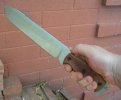I agree with Twindog - I would use a different tool for that job. But, if I had to use a knife for batoning, I would choose a saber grind, like a Sykco 711
from their website: The Leatherneck-SF (for Semper-Fi) has a saber ground clip point blade. It's hollow ground and honed by hand to a startling razor sharpness
It's not a good sign when a maker can't get their ad-copy straight (Since it's hollow-ground it ain't saber ground). That blade is designed more for stabbing than chopping, (for batoning, you normally don't want a swedge or clip point, again that's for stabbing).
The steel: German 4116 Stainless Steel: A fine grained, stainless steel produced by Germanys ThyssenKrupp. Often used for medical devices and food processing, the steels Carbon and Chromium content give it a great degree of corrosion resistance, as well as strength and edge retention. 4116 Stainless Steel has a Carbon Content between 0.42-0.55 and its Chromium content is between 13.8-15.
Doesn't sound like a particularly tough steel - which is what you want - the Ranger uses 5160 - known for toughness - often used in choppers. I'd say the Ranger would get the job done for you, or the Becker BK7, in that price range.



